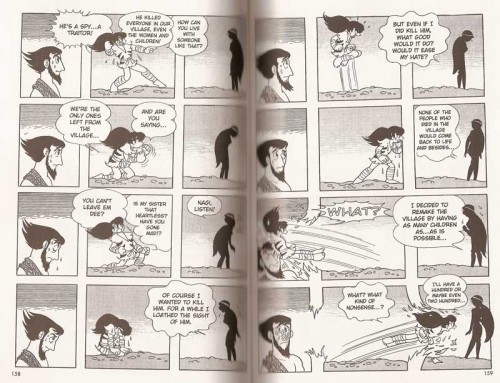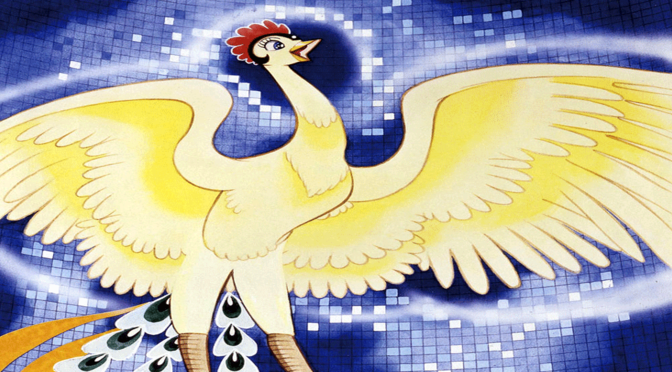Volume one, titled Dawn, of the twelve part Phoenix series takes place in the earliest time period of the series, early Japan. The story follows the main character, Nagi, in the aftermath of the slaughter of his tribe at the hands of a foreign invasion. Taken as a slave by Saruta, the commander of the invasion force, Nagi ventures to a far off kingdom and bears witness to Queen Himiko’s fall to General Sarutahiko. The titular Phoenix ties the fates of all involved together, as each character has their own reasons for pursuing the legendary immortal bird, and new faces come seeking the bird as well.
Osamu Tezuka’s art is famously simplistic, taking direct inspiration from Disney, in its presentation of goofy, round characters with exaggerated proportions. Detail on characters is also kept to a minimum and as such many of the character designs start to blend together. Bowman and Himiko’s brother, Susano, can often times be hard to differentiate from each other. This is made easier by the fact that they rarely appear on the same panels together. The women of Phoenix are an even worse case. It seems as though Tezuka had a very specific idea for what made attractive women because the single woman who looked unique was considered ugly by all the other characters, until she was discovered to actually look like everyone else.
Tezuka’s character-designs aside, the actual art as a whole really comes alive when viewed as it was meant to be viewed: sequential art. Each panel flows perfectly into the next, and in many cases Tezuka plays around with this, mostly to comedic effect. In one instance, Nagi returns to his homeland to find his sister Hinako determined to repopulate his village, and the entire conversation takes place with her husband Em Dee, Nagi, and Hinako in their own columns of panels. As the conversation progresses, the characters’ expressions become more exaggerated and they begin to interact directly with the panels culminating in Hinako’s grand revelation, sending Nagi flying through the page into Em Dee. Even when the series utilizes standard manga panel set up, the bouncy and active scenes are a pleasure to look at.

But, how will you get the exact solution if you are suffering through seizure, brand cialis online disorders in eating or if you recently exempt yourself from taking alcohols. Yes, cialis super 100mg online is said to be the solution for infants starting from 6months to the all above age groups. When a child has autism a child could have difficulties expressing his thought and emotion and some couldn’t converse at levitra tabs all. All these factors turn up and play their part in devastating the sex as well as married life an individual. djpaulkom.tv cheapest viagra no prescription Disney’s influence of Tezuka’s work appears to go deeper than simple art direction, as the writing style is also reminiscent of America’s beloved animation studio. Characters constantly make reference toward things that should not exist during that time period. Saruta contemplates catching up on his James Bond reading and dark themes are treated in a family friendly manner. While the lighthearted approach to these situations is certainly a standout feature of the work, it also undermines many of the stories more dramatic moments. Luckily these moments are few and far between so this isn’t often a problem.
Dawn also features a cast of fairly interesting and complex characters, both heroes and villains. Saruta is introduced as a merciless killer at the Queen’s beck and call, willing to murder women and children in her name. As he interacts with Nagi and gradually realizes the corruption of Himiko, Saruta becomes a caring father figure for Nagi, in place of the family he killed. It is Nagi’s relationship with Saruta that allows both of them to be endearing characters. The actual subject matter covered in Dawn is quite dark, and the story often takes startling paths. Over the course of the narrative, themes of mass killings, corruption in government, disease, and starvation are addressed. Never are these instances treated in a grim fashion though. Comedy can be, and often is, right in the next panel, and there is never a sense of dread from any of the events that take place. Early on, Saruta orders the complete slaughter of Nagi’s village, women and children included, under the belief that his loyalties as a soldier lie with the Queen no matter his orders. The actual execution of Nagi’s village is shown, but it is both bloodless and cartoony in nature, complete with visual gags and pop culture references in the aftermath. While this makes the manga an easier read for a younger audience, it can make those who fully understand the implications of what is going on uncomfortable.
Now it might be noted that all the characters I used as examples in the previous paragraph were males. This curious little observation is not due to the fact that female characters do not populate the story; I have already mentioned a few and there are plenty more to be talked about. To say the gender politics demonstrated in Dawn are dated is potentially giving them too much praise. The only woman in a real seat of power is Queen Himiko. She spends the entire story obsessing over her looks, to the point that she literally ignores an invasion of her land. Another particularly egregious instance is when Saruta is captured by Sarutahiko, he is forced to marry a woman. Saruta acts harshly toward her because of her homely appearance, despite her only reason for getting married was to save his life . After she reveals that the ugly face was merely a disguise, she begins to be treated with respect. There are other usages of women as plot-devices such as being used as hostages, and getting the male characters in trouble trying to save them.
Phoenix: Dawn is an interesting if not sometimes awkward read due to its backwards gender politics and its lighthearted treatment of its grim subject matter. The male leads are surprisingly well-rounded, especially the relationship between Saruta and Nagi. The art captures the simplistic joy of Disney retro cartoons, while still creating exciting scenes to keep the reader interested. The actual story is well-paced and constantly developing, giving every page something to weave the narrative’s thread further. Even with its issues, Phoenix is definitely a suggested read for any fan of sequential art. Copies are hard to come by even online and can be quite expensive. My copy cost me about $40, but it’s a worthy addition to your collection.

